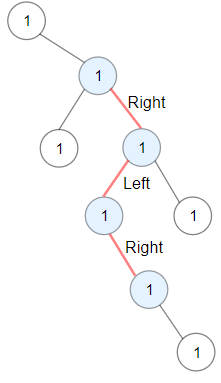Longest ZigZag Path in a Binary Tree
Given a binary tree root, a ZigZag path for a binary tree is defined as follow:
- Choose any node in the binary tree and a direction (right or left).
- If the current direction is right then move to the right child of the current node otherwise move to the left child.
- Change the direction from right to left or right to left.
- Repeat the second and third step until you can't move in the tree.
Zigzag length is defined as the number of nodes visited - 1. (A single node has a length of 0).
Return the longest ZigZag path contained in that tree.
Example 1:

Input: root = [1,null,1,1,1,null,null,1,1,null,1,null,null,null,1,null,1] Output: 3 Explanation: Longest ZigZag path in blue nodes (right -> left -> right).
Example 2:

Input: root = [1,1,1,null,1,null,null,1,1,null,1] Output: 4 Explanation: Longest ZigZag path in blue nodes (left -> right -> left -> right).
Example 3:
Input: root = [1] Output: 0
Constraints:
- Each tree has at most 50000 nodes..
- Each node's value is between [1, 100].
Solution:
/**
* Definition for a binary tree node.
* public class TreeNode {
* int val;
* TreeNode left;
* TreeNode right;
* TreeNode() {}
* TreeNode(int val) { this.val = val; }
* TreeNode(int val, TreeNode left, TreeNode right) {
* this.val = val;
* this.left = left;
* this.right = right;
* }
* }
*/
class Solution {
public int longestZigZag(TreeNode root) {
int[] max = new int[]{0};
helper(root, null, max, new int[]{0, 0});
return max[0];
}
private void helper(TreeNode root, TreeNode prev, int[] max, int[] len) {
if (root == null) return;
int left = 0;
int right = 0;
// prev go down left
if (prev != null && root == prev.left) {
left = len[1] + 1;
}
// prev go down right
if (prev != null && root == prev.right) {
right = len[0] + 1;
}
max[0] = Math.max(max[0], Math.max(left, right));
helper(root.left, root, max, new int[]{left, right});
helper(root.right, root, max, new int[]{left, right});
}
}